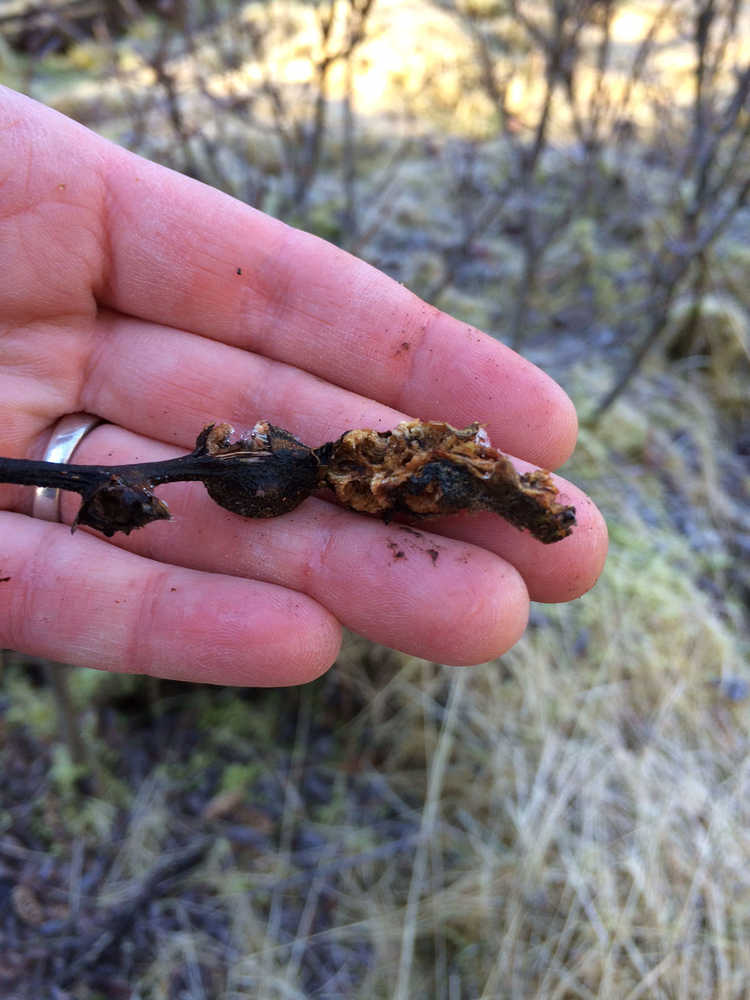Walking through the expansive stands of willow in Gustavus could give one the impression that a tall lawnmower had been at work. Many of the willows have been cropped off by browsing moose.
Other critters have been at work on the willows, too. There were many round galls — growths or lumps — on the remaining twigs. I was informed that this gall-maker is a midge, but not the same species as the one that makes ‘willow roses.’ Some of these round galls had exit holes, where a mature adult midge had emerged, after spending its larval life inside. A few galls were intact, but many of them had openings torn in the side of the gall, exposing the interior. We guessed, and this was later confirmed by a local naturalist, that these excavations were made for foraging chickadees. How do they know that there is an edible morsel inside the gall? Do they hear it as it eats through the plant material? Do they know from opening other structures that this kind also might have snacks inside? Once an excavation is rewarded by a tasty grub, I’d bet that the excavating chickadee quickly repeats the activity in search of more rewards.
As we walked down an old roadway, a few miles from the sea, we saw a solitary mew gull slowly and purposefully striding ahead of us. It seemed to be searching for something and occasionally picked up small objects. It tested these items in its bill, perhaps for shape, for size, or for texture, before swallowing them. Try as we might, we could not see what those items were. We looked in the places we’d seen the bird searching and could find no scattered seeds, no worms, nothing edible-looking. A truck went by, displacing the gull, which went right back to its former activity. This was serious business for the bird.
The gull was now behind us, so we went on, looking at other things. On our way back, that gull was still there, still picking up small items, and still searching carefully for more. But this time, we caught the action more closely and saw that the bird was selecting small stones. That was a big surprise, but we learned later that other naturalists had seen this kind of activity too.
But what would a mew gull do with a few dozen pebbles in its digestive tract? Turkeys, grouse, and seed-eating songbirds often collect pebbles for their muscular gizzards, where food particles are ground up and passed back up to the stomach for more processing or down to the intestine for absorption of the nutrients. In fact, they commonly develop a more muscular gizzard in seasons when more hard food needs to be ground up. Birds lack teeth, and gizzard stones are another way of milling tough food down to small, more readily digestible, particles. Hard stones work best, naturally, and we had a report of grouse gizzards that were loaded with matched sets of white quartz pebbles—very hard, and obviously carefully selected by the birds.
Now the plot thickens. Some online sources say that all birds have gizzards. Some say that owls, hawks, and gulls do not. Others say that owls, hawks, and gulls use their gizzards, not for grinding, but for forming pellets of indigestible material (feathers, bones, shells) that the birds cast from their mouths after sorting out the digestible parts.
I can’t resolve these contradictions without dissecting some gulls, owls, or hawks or finding an expert who has done so. I’m guessing that the sources stating that gulls, owls, and hawks lack a gizzard should be interpreted to mean that they don’t have heavily muscularized ones like those of grouse. So now I would like to know precisely how the structure of their gizzards differs from that of grouse and turkeys. And does it have special modifications to facilitate pellet formation? That leaves the basic question of what a mew gull would use those pebbles for.
And further…what then about ravens? They are pellet-casters too, coughing up tidy lumps of undigested seeds and shells. What sort of gizzard do they have?
As often happens, we end our little explorations with more questions than answers. That keeps things interesting!

